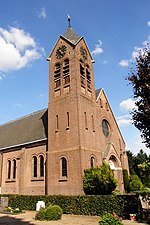Sint-Oedenrode

Sint-Oedenrode (Dutch pronunciation: [sɪnt ˈudə(n)roːdə] (listen)) is a town in the province of North Brabant. Sint-Oedenrode is a moderately urbanized town in the Meierij of 's-Hertogenbosch. Sint-Oedenrode had an unknown population as of 2021 and has an area of 64.94 km2 (25.07 sq mi). On 1 January 2017 Sint-Oedenrode, together with Schijndel and Veghel, merged into a new municipality called Meierijstad creating the largest municipality of the province North-Brabant in terms of land area.The municipality traditionally had "vrijheidsrechten" (a predecessor of city rights), since 1232, until the abolishment of the privileges and introduction of the Municipalities Act in 1851. In those feudal times Sint-Oedenrode was referred to as a "Vlek" (market town). Today it is still a large town. From southeast to northwest, the town is split by the river Dommel.
Excerpt from the Wikipedia article Sint-Oedenrode (License: CC BY-SA 3.0, Authors, Images).Sint-Oedenrode
Achterpad, Meierijstad
Geographical coordinates (GPS) Address Nearby Places Show on map
Geographical coordinates (GPS)
| Latitude | Longitude |
|---|---|
| N 51.566666666667 ° | E 5.4666666666667 ° |
Address
Scouting Rooi
Achterpad 3
5491 GV Meierijstad
North Brabant, Netherlands
Open on Google Maps









